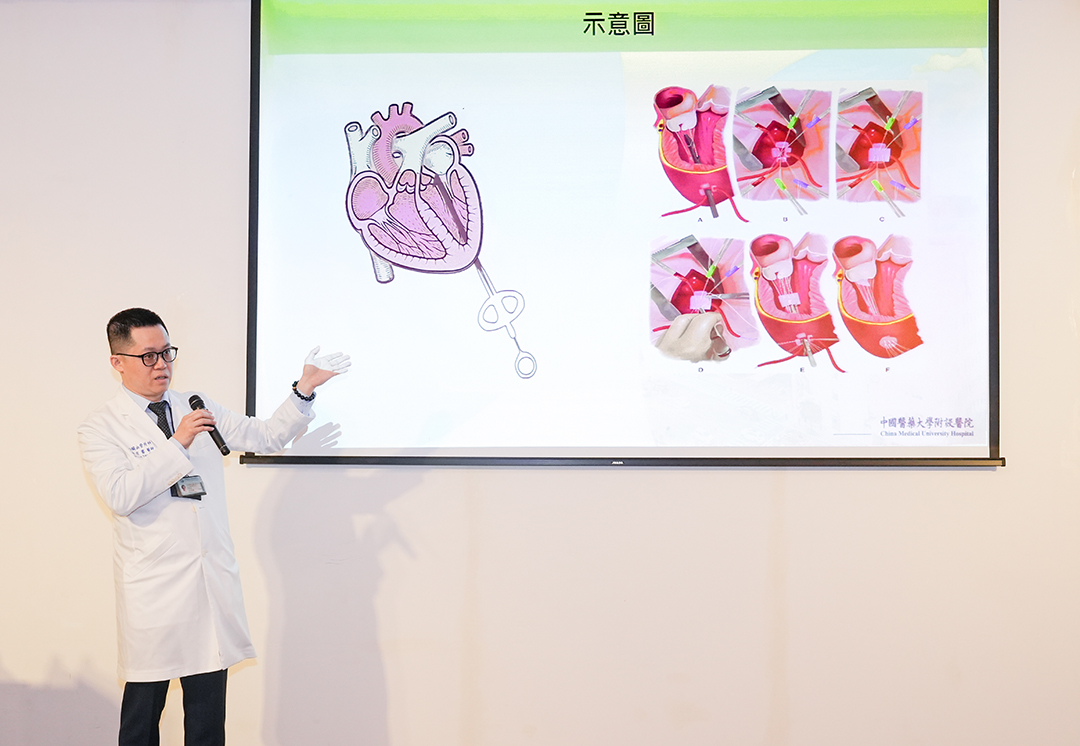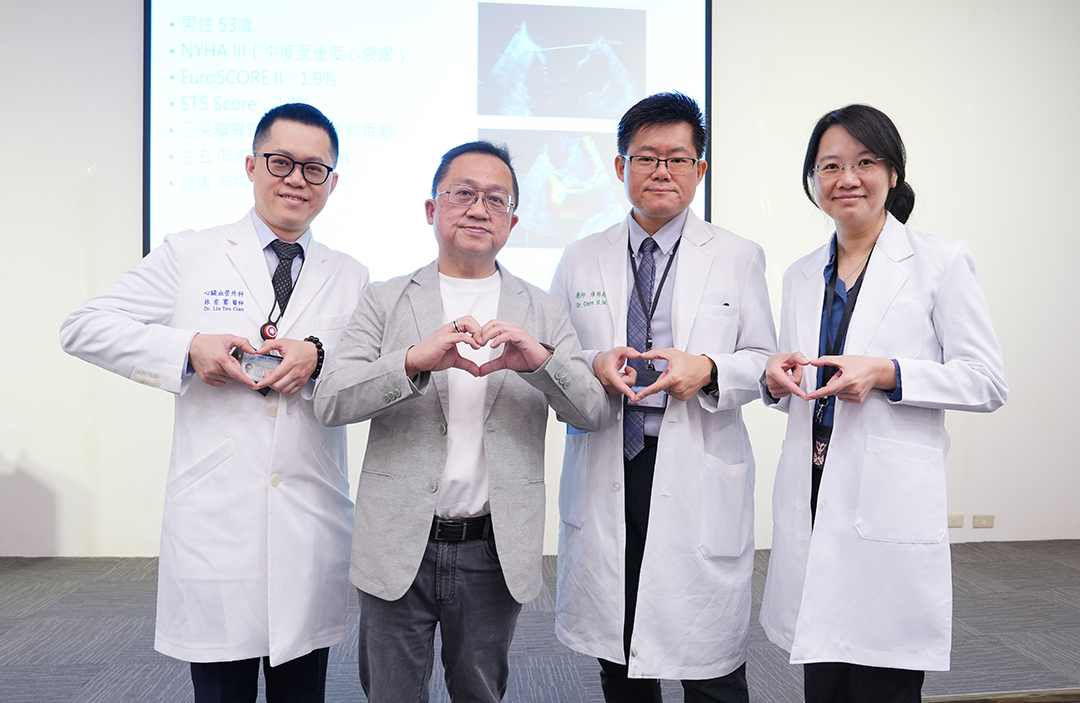News and Award
About CMUH
Double Heart Attack” Survivor Undergoes Taiwan’s First NeoChord + PCI Procedure— No Open‑Chest Surgery Needed
Double Heart Attack” Survivor Undergoes Taiwan’s First NeoChord + PCI Procedure—
No Open‑Chest Surgery Needed

A 53-year-old man surnamed Lin from Taichung suffered from palpitations, chest tightness, and decreased physical stamina for two years. After medical evaluation, he was diagnosed with severe mitral valve prolapse with regurgitation and critical stenosis of the coronary artery—facing a dual threat to his heart. Fortunately, under the care of the Integrated Cardiac Care Team at China Medical University Hospital, he successfully underwent Taiwan’s first combined NeoChord (beating-heart artificial chordae repair) and PCI (percutaneous coronary intervention) procedure. This innovative approach avoided the need for open-chest surgery or cardiac arrest, resolving both cardiac conditions with minimally invasive techniques. Just three days after surgery, Mr. Lin was able to leave the hospital. He shared his gratitude: “I thought I would need open-heart surgery and a long hospital stay, but it was just a small incision. It feels like my heart has had a tune-up—I can walk without getting out of breath now!”
Although Mr. Lin had no history of congenital heart disease, he had long suffered from hypertension and hyperlipidemia, and in recent years experienced recurring shortness of breath and declining stamina. Examinations revealed that his mitral valve prolapse and flail caused severe regurgitation, and that the mid-segment of his left anterior descending artery was nearly completely blocked. If not promptly treated, these issues could have led to heart failure or myocardial infarction.
 Dr. You-Cian Lin, Director of Cardiovascular Surgery at CMUH, explained that patients with combined valvular and vascular disease typically required traditional open-heart surgery and bypass grafting in the past, both of which entail high surgical risks and long recovery periods. This time, the hospital adopted the NeoChord technique, which allows precise implantation of artificial chordae through a small 3–5 cm incision at the left ventricular apex under continuous 3D transesophageal echocardiographic guidance, all while the heart continues to beat. At the same time, Dr. Ke-Wei Chen, Director of Cardiology, performed PCI to place a stent in the left anterior descending artery, restoring blood flow to the heart muscle—thus truly achieving “one procedure, two solutions.”
Dr. You-Cian Lin, Director of Cardiovascular Surgery at CMUH, explained that patients with combined valvular and vascular disease typically required traditional open-heart surgery and bypass grafting in the past, both of which entail high surgical risks and long recovery periods. This time, the hospital adopted the NeoChord technique, which allows precise implantation of artificial chordae through a small 3–5 cm incision at the left ventricular apex under continuous 3D transesophageal echocardiographic guidance, all while the heart continues to beat. At the same time, Dr. Ke-Wei Chen, Director of Cardiology, performed PCI to place a stent in the left anterior descending artery, restoring blood flow to the heart muscle—thus truly achieving “one procedure, two solutions.”
Dr. You-Cian Lin further noted that Mr. Lin was an ideal candidate for NeoChord, with typical posterior leaflet prolapse, suitable valve conditions, and preserved left ventricular function. This successful operation was made possible through the full support of the interventional cardiology team led by Dr. Ke-Wei Chen and the anesthesiology ultrasound team led by Dr. Ju-Hsin Chang, who provided real-time navigation and structural measurements during the procedure. Mr. Lin was able to get out of bed on the day of surgery and was discharged on the third day, recovering rapidly. This integrated minimally invasive approach not only avoids the risks of open-heart surgery and cardiopulmonary bypass but also greatly shortens hospital stay and recovery time, demonstrating the significant advantages of minimally invasive treatment.
The NeoChord technique is already widely used in Europe and the United States, becoming a mainstream treatment for structural heart disease. Having introduced this technology, CMUH will continue to expand its use to benefit more elderly and complex patients, aiming to establish a regional minimally invasive center for structural heart disease. With a commitment to precision, personalized integration, and minimally invasive approaches, the hospital is ushering in a new era of customized cardiac treatment.

Dr. You-Cian Lin reminds the public that if you experience palpitations, shortness of breath, chest tightness, sudden drop in stamina, or abnormal heart sounds on auscultation—especially if you also have hypertension, hyperlipidemia, diabetes, or a family history of heart disease—you should seek medical attention early. Through echocardiography, cardiac catheterization, and 3D imaging, early detection of structural heart disease and coronary artery risk is possible, allowing for timely planning of appropriate treatment.
Comparison of Surgical Approaches
|


![[Taiwan–Malaysia Medical Innovation Forum] CMUH and UNIMAS Co-Host Major Medical Symposium to Advance Medical Technology and Precision Patient Care img](/FileUploads/News/20250714_131324.jpg?w=250&h=180&mode=crop&scale=both)
